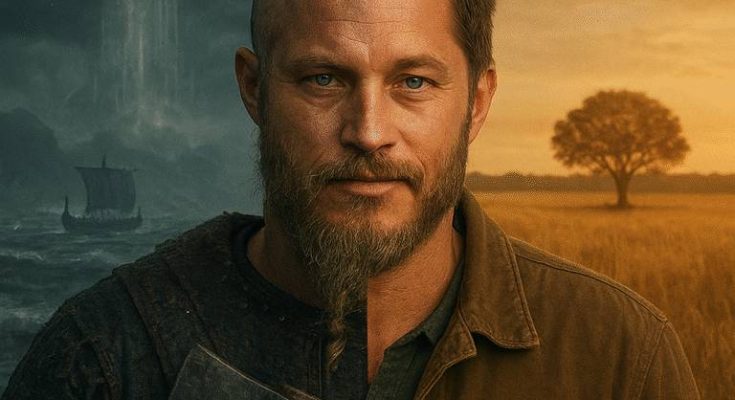“Beyond the Shores of Valhalla: How Travis Fimmel’s Real-Life Journey From Model to Viking Icon Redefined Fame, Grit, and Hollywood Stardom”
Travis Fimmel is a name that resonates with fans of epic television and cinematic drama, but the story behind the man who became the iconic face of Vikings is far more compelling than his on-screen heroics. His journey from an Australian model to an internationally recognized actor embodies the rare combination of raw talent, relentless ambition, and an enigmatic presence that Hollywood rarely encounters. Fimmel’s path has been anything but conventional, and it is precisely this unconventionality that has helped him carve a place in the hearts of millions across the globe.
Born in Echuca, Victoria, Australia, in 1979, Fimmel’s early life was grounded in a quiet, rural environment. The son of a truck driver and a nurse, he was far removed from the glitz and glamour that would later define his professional life. Growing up, Fimmel displayed a natural athleticism and an undeniable charisma that made him stand out in local sports and social circles. Yet, at the time, the idea that he would one day dominate screens worldwide seemed almost unimaginable. His path to stardom was not paved by privilege or industry connections but by a combination of serendipity and an unyielding determination to succeed.
Fimmel’s first brush with fame came unexpectedly through the world of modeling. After winning a national modeling contest in Australia, he was catapulted into the international fashion scene, signing with a prestigious agency. He quickly became the face of numerous high-profile campaigns, gracing the pages of top fashion magazines and walking the runways of global fashion capitals. His modeling career was lucrative and prestigious, yet it was evident even then that Fimmel’s ambitions extended beyond static images and runway lights. He yearned for storytelling, for a medium where he could embody characters, explore human emotion, and connect with audiences on a deeper level.
The transition from model to actor is notoriously challenging. Many models attempting the leap find themselves typecast or dismissed entirely. Fimmel, however, defied this norm through a combination of discipline, instinct, and sheer talent. He studied acting with a focus on developing a nuanced understanding of character, learning to convey emotion through subtle expressions and controlled intensity. His early roles in Australian television laid the groundwork for his breakthrough, offering him opportunities to hone his craft and gain the confidence necessary to tackle more demanding projects.
The turning point in Fimmel’s career came with his casting as Ragnar Lothbrok in the hit historical drama series Vikings. The role was nothing short of transformative. Ragnar, a legendary Norse hero, demanded a delicate balance of physical prowess, intellectual cunning, and raw emotional depth—qualities that Fimmel brought to life with astonishing authenticity. Audiences were captivated not only by his rugged appearance but by the depth he brought to the character. His portrayal of Ragnar was a masterclass in blending strength and vulnerability, making a centuries-old Viking legend feel human, relatable, and profoundly compelling. It was a performance that would define his career and set a new benchmark for actors tackling historical roles.
Fimmel’s rise to fame through Vikings was accompanied by challenges that tested his resilience and dedication. The series required intense physical preparation, including combat training, endurance work, and the ability to perform demanding stunts. Yet, Fimmel approached these challenges not as obstacles but as opportunities to deepen his connection to the character. He immersed himself fully, often spending long hours mastering the intricacies of Viking life, from traditional weaponry to the rituals and cultural nuances of the time. His commitment to authenticity earned him respect not only from fans but also from historians and critics alike, cementing his reputation as an actor who takes his craft seriously.
Beyond the physical and emotional demands of Vikings, Fimmel navigated the complexities of international fame with remarkable grace. Unlike many of his contemporaries, he has maintained a level of privacy and humility that is increasingly rare in the entertainment industry. He rarely seeks the spotlight outside of his professional work, allowing his performances to speak for themselves. This approach has created an aura of mystery around him, intensifying public fascination and further elevating his status as a modern icon.
Fimmel’s impact extends beyond the confines of television. He has become a cultural touchstone, influencing fashion, lifestyle, and popular perceptions of masculinity and heroism. His ability to embody strength without sacrificing vulnerability has resonated deeply, inspiring fans to appreciate the complexity of character and the power of authentic self-expression. He demonstrates that fame need not equate to vanity or superficiality; instead, it can serve as a platform for storytelling, emotional resonance, and artistic integrity.
Despite his international acclaim, Fimmel has remained grounded, consistently returning to the values instilled in him during his early years in rural Australia. He is known for his generosity, humility, and approachability, qualities that endear him to colleagues and fans alike. He has spoken in interviews about the importance of staying true to oneself and the need to embrace both successes and setbacks with equanimity. His journey underscores the notion that true greatness is not defined solely by talent or opportunity but by character, resilience, and the courage to follow one’s passion relentlessly.
Fimmel’s story also highlights the evolution of contemporary acting careers. In an era dominated by blockbuster franchises and social media influence, he has succeeded by prioritizing craft over hype. His career trajectory reflects a dedication to meaningful roles, careful selection of projects, and an understanding of the profound impact that thoughtful storytelling can have on audiences. He embodies the ideal that fame is a tool, not a goal, and that genuine artistry is what endures long after the spotlight fades.
As Travis Fimmel continues to explore new roles and creative endeavors, his legacy is firmly established. He is more than a model-turned-actor or a television icon; he is a symbol of perseverance, authenticity, and the transformative power of storytelling. From the quiet townships of Australia to the global stages of Hollywood, his journey serves as an inspiring testament to what can be achieved when talent meets determination and opportunity is seized with courage.
For fans and admirers, Fimmel represents a rare combination of myth and reality. He has taken a figure rooted in legend—Ragnar Lothbrok—and infused him with humanity, creating a cultural touchstone that transcends the boundaries of screen and story. At the same time, his own life story mirrors the qualities he portrays: grit, resilience, and an unyielding quest for meaning and excellence. Through his work and his example, he continues to challenge conventional notions of fame, artistry, and identity, proving that true icons are defined not just by what they do, but by the authenticity with which they live their lives.
In reflecting on Travis Fimmel’s extraordinary journey, one is reminded that the path to greatness is rarely linear. It is forged through risk, perseverance, and the courage to embrace both the known and the unknown. Fimmel’s evolution from an Australian model to a Viking legend and Hollywood star is a story that inspires, captivates, and resonates—a reminder that beyond the shores of Valhalla lies a world where ambition, talent, and humanity converge to create something truly legendary.



